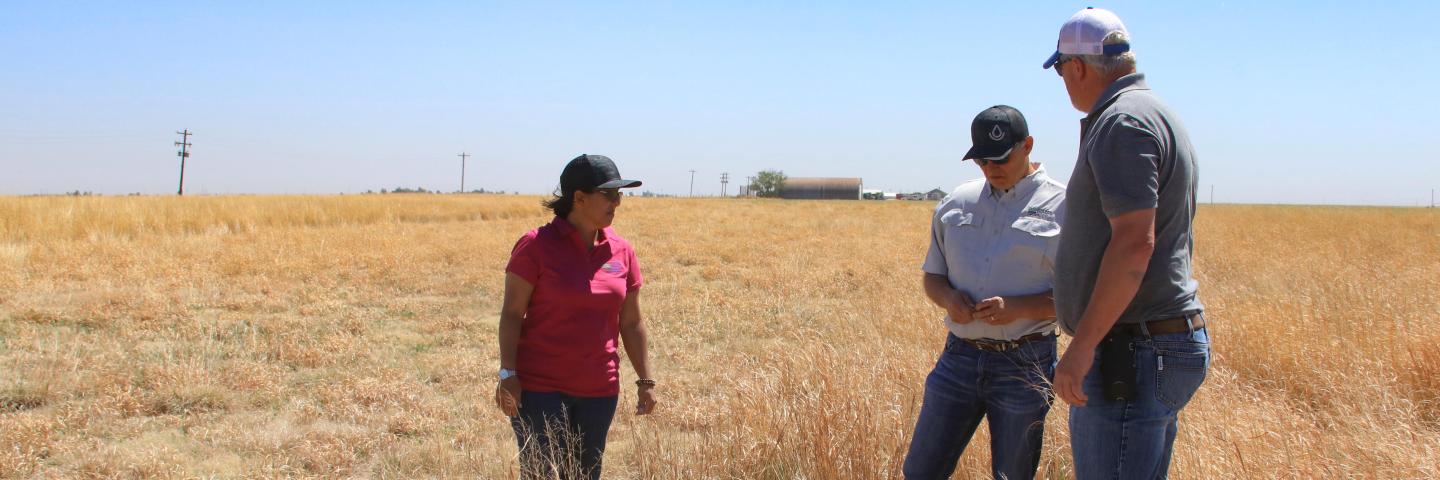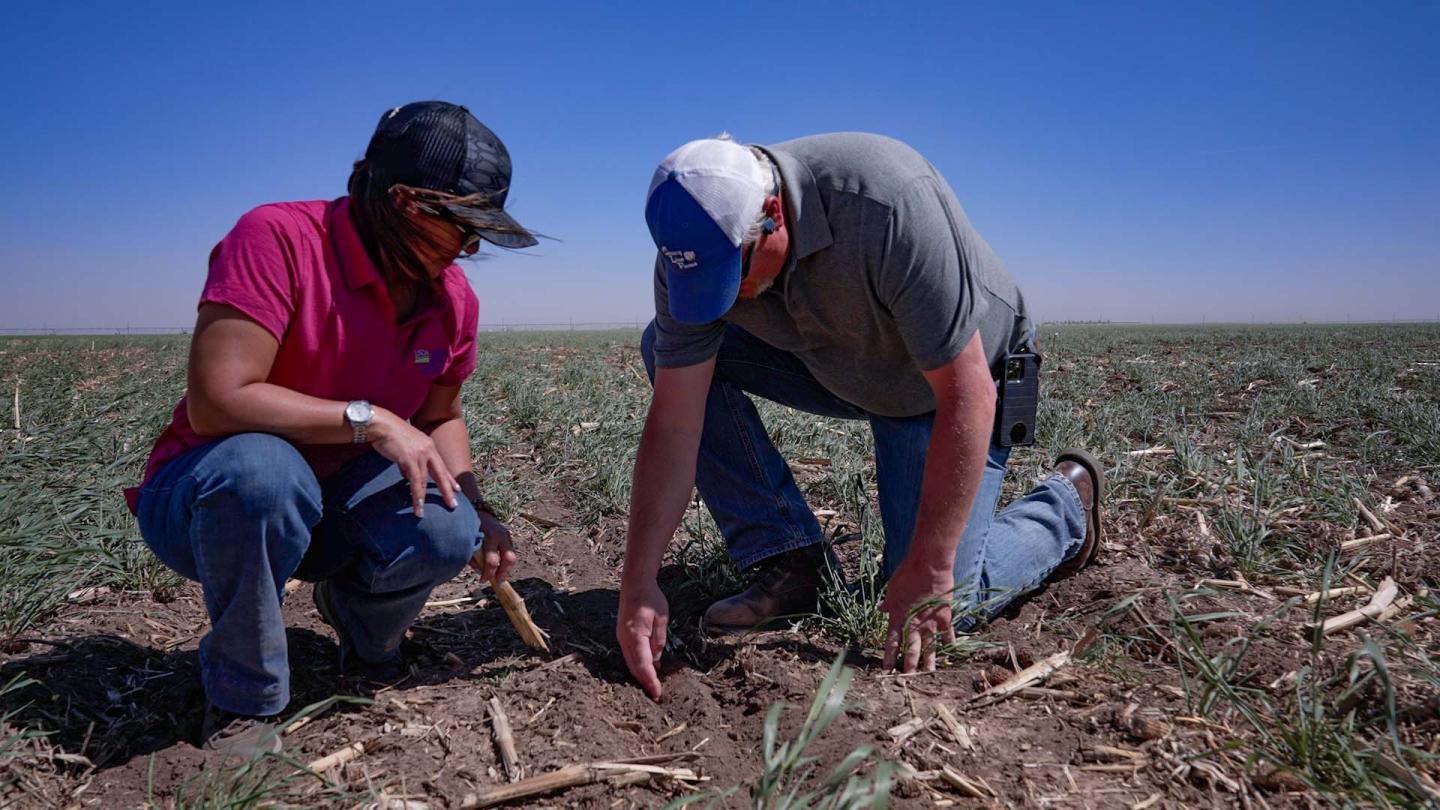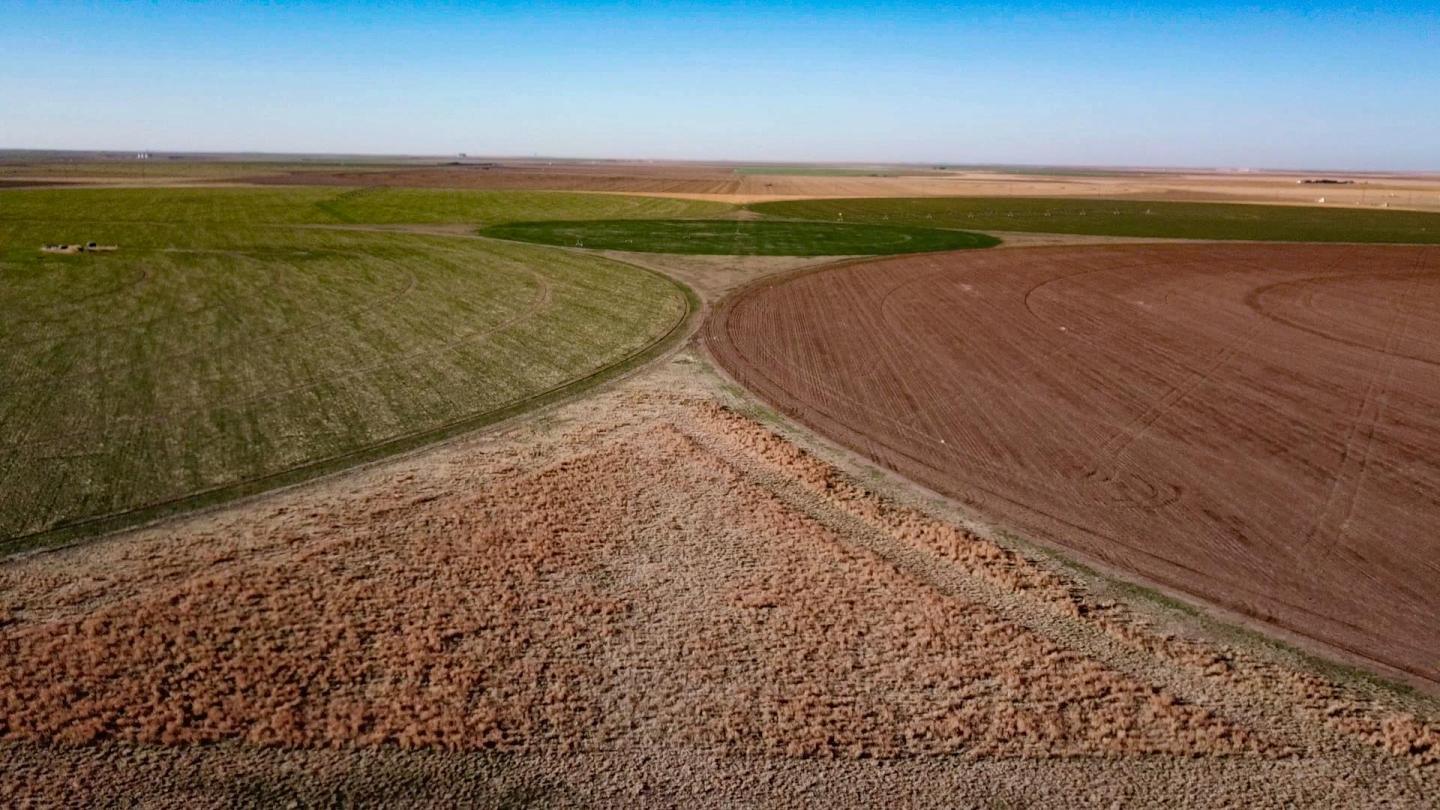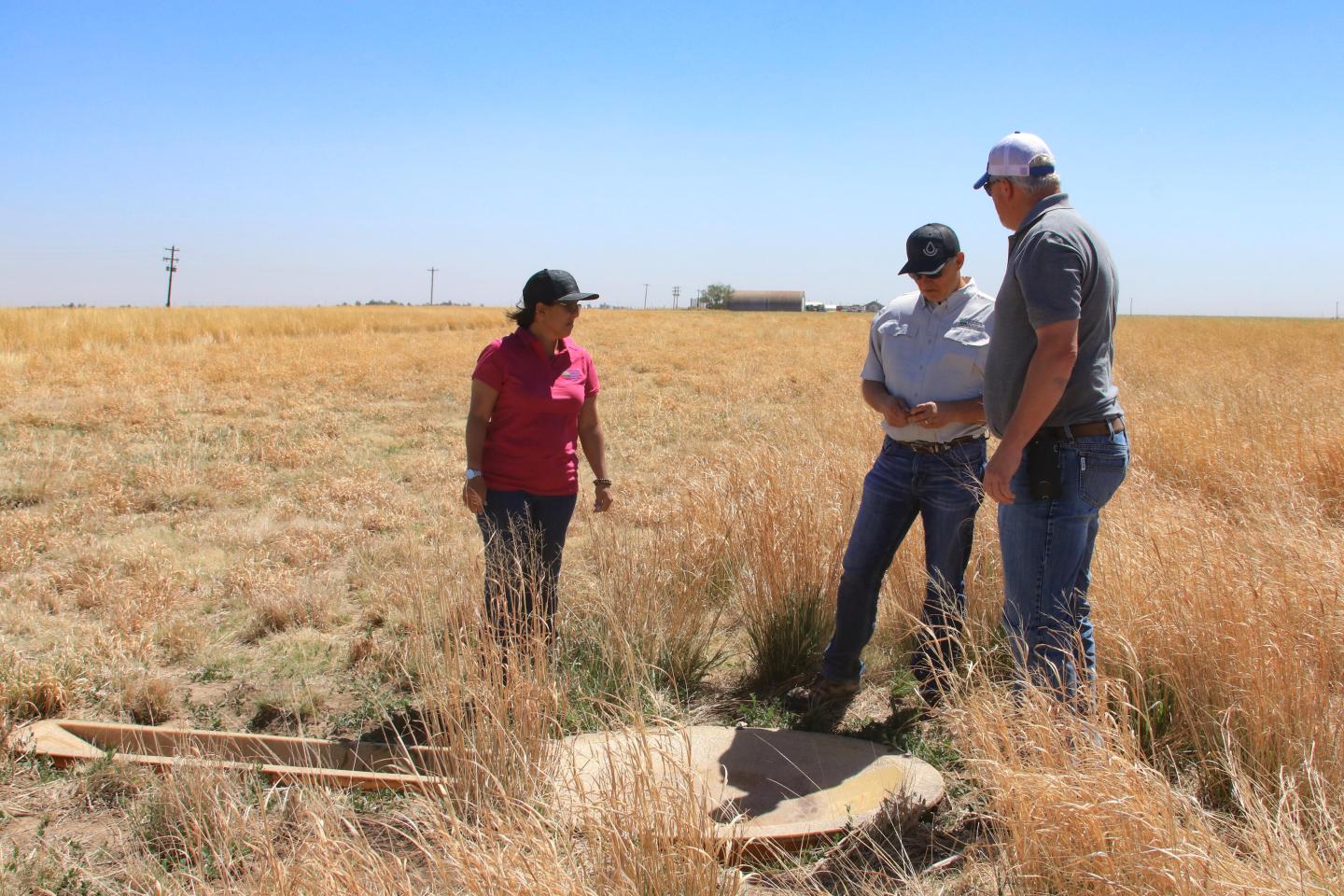Celebrating a lifetime of conservation in the Texas Panhandle

NRCS helps Williams family grow cotton, corn in a sustainable way.
Story and photos compiled by Quenna Terry, Public Affairs Specialist, Lubbock, TX
Celebrating a lifetime of conservation in the Texas Panhandle ArcGIS Storymap
You could say Bryce Williams learned about farming and overcoming the challenges that come along with it pretty early on. He recalls going out into the fields at his family’s farm as a little boy, along with his brother, where they row irrigated and picked up irrigation pipe.
“I was probably five when I started working on the farm,” he said. “I had to kneel on the floorboard of the pickup, throwing the gas and the brake, and my brother had to kneel on the seat to steer because we weren’t big enough to do both.”
And while that may sound like a lot to navigate for someone so young, Williams said his dad Bob, who has been farming for 74 years, was great teacher who watched and supported them every step of the way—and still does.
“He brings a lot to the table,” said the younger Williams of his dad. “It’s typical working with family. It’s had its moments, but there’s been lots of support and that’s been great.”
Bryce’s stepmom Linda also has had an impact, not just on Williams, but the agricultural community where they live, as she has served on the state committee of the Texas FSA over the years.
The Williamses also have a long history of working with the USDA Natural Resources Conservation Service (NRCS). The agency continues helping the Williams family grow cotton and corn in a sustainable way, considering things that are critical to farmers in an area where rain or rivers are in short supply. That’s where water management and soil health assistance through the NRCS Environmental Quality Incentives Program (EQIP) have come into play.
“I started working with the Williams family as soon as I got to Spearman in late 1994,” said Rick Harrell, the NRCS Resource Team Leader in the Spearman office, which is located in the northern part of the Texas Panhandle. Harrell began working directly with Bryce Williams in 2000 after he decided to expand his operation into the eastern part of the region.
Since that time, the Williams family and NRCS have developed a good working relationship at County Line Farms II, named as such because the farm splits the county line. “We’ve had the initial part of this farm for over 40 years and added on here about 18 years ago,” says Williams about the name of the family enterprise.
With an eye on innovation and improvement, areas of interest have included a focus on enhancing the land for wildlife, as well as achieving better air quality and soil health through cover crops, grass corners, rainfall catchment, pipeline replacement, and sprinkler conversions.
Setting the farming record straight on conservation
“Lots of times in the media, farmers are portrayed as just taking from the land and not putting anything back. I don’t know any farmers who are not the best stewards they can be,” Williams said.
He said he doesn’t mind setting the record straight when it comes to lingering perceptions some people may have about farmers. Take the precious resource of water for instance – something already hard to come by in this part of the world, but especially throughout the lingering drought that continues to plague Texas.
As part of the stewardship Williams preaches, he explains that limiting water pumping on County Line Farms II helps to conserve groundwater for future generations. “If we don’t protect it, our water supply won’t be here for us, much less future generations,” he said. “We could easily pump everything out really quickly and this country would turn back into a desert.”

With the help of NRCS, the Williamses replaced sprinklers and pipelines on County Line Farm, gaining water efficiency with both. He’s found water management efficiencies as well as other resource conservation plans around his property have not only cut costs, but have worked to conserve energy, too.
Since Williams farms cross county lines, he works with NRCS personnel in Hansford and Ochiltree counties. Harrell assists Williams with his farms in Hansford County, and Sonia Burgos Colon, NRCS district conservationist in Perryton works with Williams on his conservation endeavors in Ochiltree County.
“They’ve taken several places with low irrigation pipes where there were leaks to be more efficient and more modern than what they had initially, and also done work on their pumps that has improved their efficiencies and energy on their irrigation,” said Harrell. They also replaced their center pivot, which now uses variable frequency drive pumps, which help control pump speed/electricity for improved efficiency.
“My favorite is the grass program,” Williams said, explaining that most farmers in that area don’t like messing with the small corners around their fields. On smaller farm circles, the corners are too tricky to navigate machinery around, so they are generally left to fall to the wayside. Williams, however, has a different approach.
“Probably one of the things Bryce is most proud of is planting a lot of his dryland corners to grass,” said Harrell.

Williams estimates the corners account for a little over 500 acres-worth, at seven acres of apiece. Each corner now contains a buffet of grasses including a combination of spangle grass, Blackwell switchgrass, sideoats grama, blue grama, and buffalo grass.
“When we came up with that mix, I sat down with Rick and asked his opinion. Those are all native grasses and the seeds that they make are seeds the birds will eat,” said Williams. While other grasses may have grown in faster or cheaper, these were specifically chosen for wildlife benefit.
Explaining how and why it works, Williams said the corners help protect the crop circles from blowing from the prevailing southwest winds. The grass corners also help protect dirt from washing out as a result of some of the bigger storms that pass through dropping heavy rains.
And while the combination of water management, soil health, and the grass program itself have been a huge help in preventing both water and wind erosion, it’s turned out to be a good thing for wildlife conservation, too, according to Williams.
Mindful of the wildlife
It’s no surprise that someone so vested in the land would be vested in the wildlife that relies on that land for food and shelter. Such is the case with Williams, which is why he’s happy to supply local wildlife with tall grass, food through native grass seeds, and water, all of which are made easily accessible throughout the property.
The native grass corners have been a critical part of an increased wildlife presence, including white tail deer, but especially upland birds.
“[The Williams family] are very much into wildlife. They love to see the birds – pheasants predominately and some quail,” said Harrell. “The birds are here because of those native grasses.”
Harrell said the native grass corners also give wildlife cover, including nesting cover through the summer, shelter through the winter, and relief from the cold wind.
Another important way the Williams family cares for wildlife has been to place eight water troughs, or “guzzlers” as Williams calls, them around the farm. These, too, were installed through EQIP.

“The ones we put in are 190 gallons. You dig them down to ground level so they don’t freeze, and they have a ramp on them so smaller animals can walk down to them and don’t get trapped. The top is concaved a little bit and it gathers rainwater,” Williams said. “The ones we’ve put in, we filled them initially and we’ve never had to refill them. They’ve never gone dry.”
Having access to this water is vital for wildlife in the region, where available water resources are few and far between.
Learning from the past to prepare for the future
And while he is proud of being part of an industry that has had a hand in helping conserve the land long before it became a national headline, Williams is quick to say there is still much to learn. He recently went through a master irrigator class, along with multiple members of the family.
“It’s a great program,” he said. “It really gets in-depth about water efficiency, changing nozzles, regulators set up on irrigation sprinklers, better pipelines, more efficient pumping, drone usage, cover crops, minimum tillage, and no tillage where it’s applicable. It’s just a great resource for information sharing.”
When it comes to sharing that information, Harrell says Williams is the right person for the job.
“A lot of producers have seen what he’s done, and they’ve followed suit,” Harrell said about the Williams’ enthusiasm for grass corners. Harrell describes the County Line Farm as “kind of the poster child for that conservation practice.
“He’s got a couple places that are on the highway so they’re very visual,” Harrell said of Williams’ properties.
The entire Williams family knows that if they don’ take care of their land, that land won’t take care of them in the long run and they won’t be able to keep up with business.
Williams jokingly describes the operation of County Line Farms II as “the whole ‘famdamily.’” He said the reason behind his drive for wanting to continue in the family tradition stems from where he began his farming journey on the floorboard of that truck.
“We’ve just never done anything else,” he said.
And with a nephew that’s up and coming on the farm now, and another currently at West Texas State University and planning to come to work with on the farm after graduation, it looks like that family tradition is set to continue.


